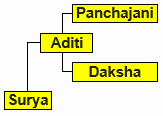Aditi
| Aditi | |
|---|---|
Goddess of the sky, consciousness, the past, the future, and fertility Danu, Muni and many other brothers and sisters | |
| Consort | Kashyapa |
| Children |
|
Aditi (Sanskrit: अदिति, lit. 'boundless' or 'limitless'[a] or 'innocence'[2]) is an important Vedic goddess in Hinduism.
She is the personification of the sprawling infinite and vast cosmos. She is the goddess of motherhood, consciousness, unconsciousness, the past, the future, and fertility.[4] She is the mother of the celestial deities known as the adityas, and is referred to as the mother of many deities. As celestial mother of numerous beings, the synthesis of all things, she is associated with space (akasha) and with mystic speech (Vāc). She may be seen as a feminine form of Brahma, and associated with the primal substance (mulaprakriti) in the Vedanta. She is mentioned more than 250 times in the Rigveda, the verses replete with her praise.
Family
Aditi is the daughter of
Origin
The first mention of Aditi is found in
According to the Shatapatha Brahmana (a commentary on the Shukla Yajurveda), Aditi is also invoked during ritual sacrificial offerings as being synonymous with the Earth:
'On the navel of the earth I place thee!' And further, 'In the lap of Aditi (the boundless or inviolable earth)!' for when people guard anything very carefully, they commonly say that 'they, as it were, carried it in their lap;' and this is the reason why he says, 'In the lap of Aditi!'
— Satapatha Bramanda (translator Julius Eggeling, 1882), 1:1:2:23[8]
Attributes
Motherhood

Aditi and the sage Kashyapa had 33 sons, out of whom twelve are called
She is also the mother of the
In the Rigveda, Aditi is one of the most important figures of all. As a mothering presence, Aditi is often asked to guard the one who petitions her (Mandala 1.106.7; Mandala 8.18.6) or to provide him or her with wealth, safety, and abundance (Mandala 10.100; 1.94.15).
Creativity

Aditi is usually mentioned in the Rigveda along with other gods and goddesses. There is no one hymn addressed exclusively to her, unlike other Vedic gods. Since She is perhaps not related to a particular natural phenomenon like other gods. Compared to Ushas and Prithvi, Aditi can be defined as the cosmic creator.
The verse "
Freedom
The name Aditi includes the root "da" (to bind or fetter) and suggests another attribute of her character. As A-diti, she is an unbound, free soul and it is evident in the hymns to her that she is often called to free the petitioner from different hindrances, especially sin and sickness. (
Might
Aditi was attributed the status of first deity by the Vedic culture, although she is not the only one attributed this status in the Vedas. She is addressed in the Rigveda as "mighty" and revered as the eternal mother of all creation.[citation needed]
Others
Like many other Hindu gods and goddesses, Aditi has a vahana (a mount). Aditi flies across the boundless sky on a phoenix.[13] The phoenix symbolizes strength, honour, but most importantly, reflects Aditi's nature of cyclical rebirth and infinite creation.
Her weapons include the famous trishula, and a sword.
Aditi is described to possess a pair of earrings, which are stolen from her by the asura named Naraka. Krishna returns the earrings to her after slaying the asura with his consort, Satyabhama.[14]
Worship
A well known old temple of Aditi is located near rock cut cave in Vizhinjam, Kerala.[citation needed]
See also
- Payovrata
- Adityas
- Surya Namaskar
- Sun worship in Hinduism
- List of solar deities in Hinduism
- List of Surya temples
- List of Hindu deities
- List of Hindu pilgrimage sites
- List of Hindu temples
Notes
- privative aand diti "bound," which is from the Proto Indo-European root *da- "to bind."
References
- ^ "Aditi: 26 definitions". 11 April 2009.
- ^ a b c
Jamison, Stephanie; Brereton, Joel (2015). The Rigveda — Earliest Religious Poetry of India. Oxford University Press. p. 43. ISBN 978-0190633394– via Google Books.
- ^
Mani, Vettam (2015). Puranic Encyclopedia: A comprehensive work with special reference to the epic and Puranic literature. Motilal Banarsidass. ISBN 978-81-208-0597-2– via Google Books.
- ^ "Aditi (Hindu deity)". Encyclopædia Britannica. Ancient Religions & Mythology. 20 June 1998. 5981. Retrieved 30 June 2021.
- ^ www.wisdomlib.org (19 December 2011). "Aditya, Āditya: 38 definitions". www.wisdomlib.org. Retrieved 13 October 2022.
- ^ Gopal, Madan (1990). Gautam, K.S. (ed.). India through the Ages. Publication Division, Ministry of Information and Broadcasting, Government of India. p. 62 – via Archive.org.
- OCLC 174616106.
- ^ "First Kânda: I, 1, 2. Second Brâhmana". Satapatha Brahmana Part 1 (SBE12). Translated by Eggeling, Julius (1882 ed.). Retrieved 28 December 2019 – via www.sacred-texts.com.
- ^
Sathyamayananda, Swami (2012). Ancient Sages. Mylapore, Chennai: Sri Ramakrishna Math. p. 173. ISBN 978-81-7505-356-4.
- ^ "Chapter 6 Verses 38-39". Srimad Bhagavatam Canto 6. Archived from the original on 20 March 2012. Retrieved 13 August 2012 – via Vedabase.net.
- ^ The Secret Doctrine 2:247n
- ^ "Adi-Ag". Encyclopedic Theosophical Glossary. The Theosophical Society – via Theosociety.org.
- ISBN 979-8-88530-354-5.
- ISBN 978-0-19-803400-1.
Further reading
- Kinsley, David (1998). Hindu Goddesses: Vision of the divine feminine in the Hindu religious traditions. Motilal Banarsidass Publications. ISBN 978-81-208-0394-7.
External links
![]() Media related to Aditi at Wikimedia Commons
Media related to Aditi at Wikimedia Commons
- "Aditi". vaniquotes.org. Quotes from the Bhagavad-gītā.

